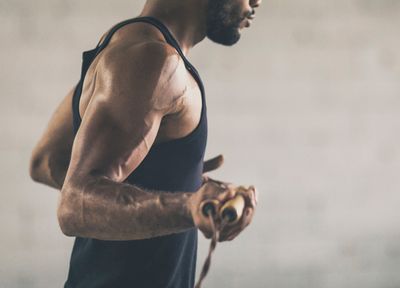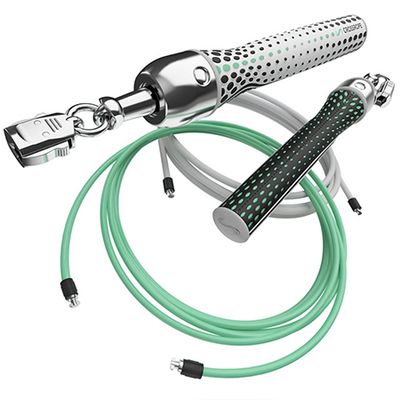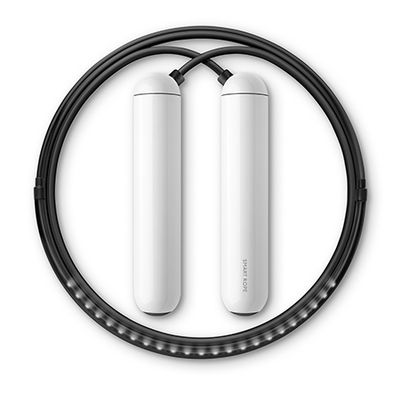
How To Work Out With A Skipping Rope
What are the benefits of skipping?
Skipping ropes provide a full-body workout that will increase cardiovascular capacity and build lean muscle mass. As Michelle Morrey, group fitness manager at Equinox, explains, “The skipping rope is a small but mighty piece of equipment. Ropes will give you a powerful athletic workout and an intense bout of cardio – it’s powerful, fun and effective. Skipping helps build power and explosiveness, improves balance, endurance, coordination and footwork skills, and is a great workout to support other forms of training like boxing. The high-impact nature of skipping also increases bone density, while complex rope tricks work to improve cognitive function.” Ian Robertson, personal training manager at Equinox Bishopsgate, reckons it’s the ultimate 2020 workout: “Skipping offers an efficient way to train with minimal space and equipment – ideal for lockdowns and home workouts."
What muscle groups does it target?
“Regularly incorporating a skipping rope into your fitness regime will benefit your posture,” says Michelle. Plus, once you get the hang of it, you’ll start to feel it in your core, biceps, pecs, delts, lats and calves. “Skipping is a great way to increase lower leg muscle size due to the constant tension the calf muscles are under,” adds Ian. Michelle’s top tip? Invest in a weighted skipping rope. “Ten minutes skipping with a 2lb weight rope is the equivalent of 30 minutes on a treadmill. Plus, weighted ropes will engage more muscles in the upper body, helping to tone your arms, shoulders and back.”
How is it different to other forms of cardio?
Unlike a high-impact HIIT class, which can quickly take its toll on the body, Ian explains that skipping creates less wear and tear on the joints, meaning you can do it more frequently, and reap the benefits. “Skipping is different from your average cardio thanks to fast adaptations. You’ll find skipping challenging if you’re new to it, and during the first month of a skipping routine, you’ll expend a lot of calories and will experience a sharp increase in performance in the first six weeks.”
Is there a right way to skip?
“Skipping, like martial arts, is all about timing and rhythm,” says Ian. “It should feel effortless – you should do nearly all the work with your lower legs for the jump, and use your wrist and hand to spin the rope. There should be minimal movement above the elbow.” Michelle recommends “floating like a butterfly” when skipping, staying light on your feet and keeping your jumps low to the ground. Keep your knees soft and your abs tight, try to keep your elbows at 45º, pulled into the ribs, and rotate from your wrist.
Where do you start?
Keep it simple, says KXU trainer Alex Lawson, and start by ensuring your technique is on point. “Keep your arms tucked in by the side of your body. Jump on your toes and make sure you bend your knees slightly throughout. Try and relax, and don’t forget to breathe – people tend to stiffen up and lose their natural breathing rhythm when learning new and complex movements.” If you’re struggling to get the mechanics right, Alex advises skipping without the rope. “You can replicate all the motions, like moving your wrists and bouncing on time. Try skipping for one minute continuously, with or without your rope, and give yourself a 30-40 second break. Aim to keep going for five minutes, building up to ten. Aim to clear the floor by one or two inches only, and keep both feet together and bounce once for each revolution.”
How can you incorporate skipping into your workout?
If you’re a beginner, try using skipping as a way to warm up for your strength training, or try a simple standalone workout, suggests Ian. “Find a comfortable pace and try skipping for two-minute intervals, resting for one minute in between. Keeping the intervals short for a beginner can help to maintain form when you’re just starting out,” he advises. Once you’ve mastered the basics, Ian recommends incorporating side swings into your routine, as well as the ‘double under’. “Once you’ve found your rhythm and are confident with your bounce, try and get the rope under your feet twice before you land.”
What should you look for when buying a skipping rope?
For something affordable, durable and lightweight, start with a plastic rope. However, as you progress, consider trying a steel cable, popular in the CrossFit community for its ability to provide a speedy skip. Always start with a lightweight rope before progressing to a weighted version. As a general rule of thumb, look for a rope three feet taller than your height.
Get involved with SLMan’s pick of the best skipping ropes…
CrossRope Get Fit Ropes, £150.68
With two interchangeable weight options and access to an app, this rope is ideal for those looking to take a structured approach to training.
Available here
Reebok Premium Skipping Rope, £20.99
With ergonomic handles and adjustable ropes, this high-street option is a beginner’s must-have.
Available here
Tangram Factory Smart Rope, £79.95
This intelligent rope syncs to an app on your phone to track jumps, calories and reps.
Available here
Alex Lawson is offering access to online skipping workouts, including tutorial videos, timed circuit workouts and tricks – message him @AlexLawsonFitness on Instagram for more information. For more information on Equinox, visit Equinox.com
DISCLAIMER: *Features published by SLMan are not intended to treat, diagnose, cure or prevent any disease. Always seek the advice of your GP or another qualified healthcare provider for any questions you have regarding a medical condition, and before undertaking any diet, exercise or other health-related programme.
DISCLAIMER: We endeavour to always credit the correct original source of every image we use. If you think a credit may be incorrect, please contact us at [email protected].


